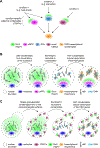The Heat Shock Response as a Condensate Cascade
- PMID: 38848866
- PMCID: PMC11214683
- DOI: 10.1016/j.jmb.2024.168642
The Heat Shock Response as a Condensate Cascade
Abstract
The heat shock response (HSR) is a gene regulatory program controlling expression of molecular chaperones implicated in aging, cancer, and neurodegenerative disease. Long presumed to be activated by toxic protein aggregates, recent work suggests a new functional paradigm for the HSR in yeast. Rather than toxic aggregates, adaptive biomolecular condensates comprised of orphan ribosomal proteins (oRP) and stress granule components have been shown to be physiological chaperone clients. By titrating away the chaperones Sis1 and Hsp70 from the transcription factor Hsf1, these condensates activate the HSR. Upon release from Hsp70, Hsf1 forms spatially distinct transcriptional condensates that drive high expression of HSR genes. In this manner, the negative feedback loop controlling HSR activity - in which Hsf1 induces Hsp70 expression and Hsp70 represses Hsf1 activity - is embedded in the biophysics of the system. By analogy to phosphorylation cascades that transmit information via the dynamic activity of kinases, we propose that the HSR is organized as a condensate cascade that transmits information via the localized activity of molecular chaperones.
Keywords: Condensate; Heat shock; Hsf1; Hsp70; Signaling cascade.
Copyright © 2024 Elsevier Ltd. All rights reserved.
Conflict of interest statement
Declaration of competing interest The authors declare that they have no known competing financial interests or personal relationships that could have appeared to influence the work reported in this paper.
Figures



Similar articles
-
Hsp70 chaperones, Ssa1 and Ssa2, limit poly(A) binding protein aggregation.Mol Biol Cell. 2025 Jun 1;36(6):ar66. doi: 10.1091/mbc.E25-01-0027. Epub 2025 Apr 9. Mol Biol Cell. 2025. PMID: 40202836
-
Transcriptional regulation of Sis1 promotes fitness but not feedback in the heat shock response.Elife. 2023 May 9;12:e79444. doi: 10.7554/eLife.79444. Elife. 2023. PMID: 37158601 Free PMC article.
-
Hsf1 on a leash - controlling the heat shock response by chaperone titration.Exp Cell Res. 2020 Nov 1;396(1):112246. doi: 10.1016/j.yexcr.2020.112246. Epub 2020 Aug 27. Exp Cell Res. 2020. PMID: 32861670 Review.
-
Regulation of the Hsf1-dependent transcriptome via conserved bipartite contacts with Hsp70 promotes survival in yeast.J Biol Chem. 2019 Aug 9;294(32):12191-12202. doi: 10.1074/jbc.RA119.008822. Epub 2019 Jun 25. J Biol Chem. 2019. PMID: 31239354 Free PMC article.
-
A guide to heat shock factors as multifunctional transcriptional regulators.FEBS J. 2025 Aug;292(16):4133-4155. doi: 10.1111/febs.70139. Epub 2025 Jun 2. FEBS J. 2025. PMID: 40457168 Free PMC article. Review.
Cited by
-
When HSFs bring the heat-mapping the transcriptional circuitries of HSF-type regulators in Candida albicans.mSphere. 2025 Jan 28;10(1):e0064423. doi: 10.1128/msphere.00644-23. Epub 2024 Dec 20. mSphere. 2025. PMID: 39704513 Free PMC article. Review.
-
Emergent 3D genome reorganization from the stepwise assembly of transcriptional condensates.bioRxiv [Preprint]. 2025 Feb 27:2025.02.23.639564. doi: 10.1101/2025.02.23.639564. bioRxiv. 2025. PMID: 40060634 Free PMC article. Preprint.
-
Preserve or destroy: Orphan protein proteostasis and the heat shock response.J Cell Biol. 2024 Dec 2;223(12):e202407123. doi: 10.1083/jcb.202407123. Epub 2024 Nov 15. J Cell Biol. 2024. PMID: 39545954 Free PMC article. Review.
-
Redox regulation of proteostasis.J Biol Chem. 2024 Dec;300(12):107977. doi: 10.1016/j.jbc.2024.107977. Epub 2024 Nov 8. J Biol Chem. 2024. PMID: 39522946 Free PMC article. Review.
-
Effects of Climate Change on the Immune System: A Narrative Review.Health Sci Rep. 2025 Apr 18;8(4):e70627. doi: 10.1002/hsr2.70627. eCollection 2025 Apr. Health Sci Rep. 2025. PMID: 40256129 Free PMC article.
References
Publication types
MeSH terms
Substances
Grants and funding
LinkOut - more resources
Full Text Sources

